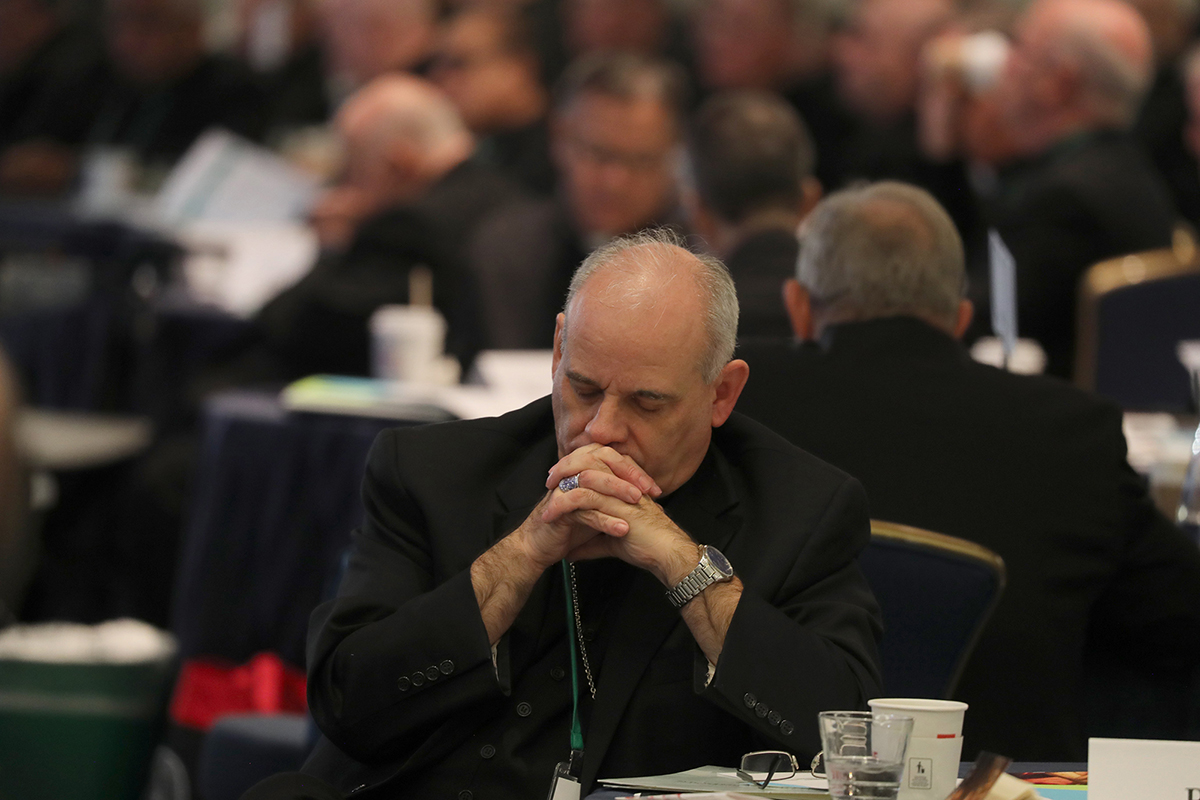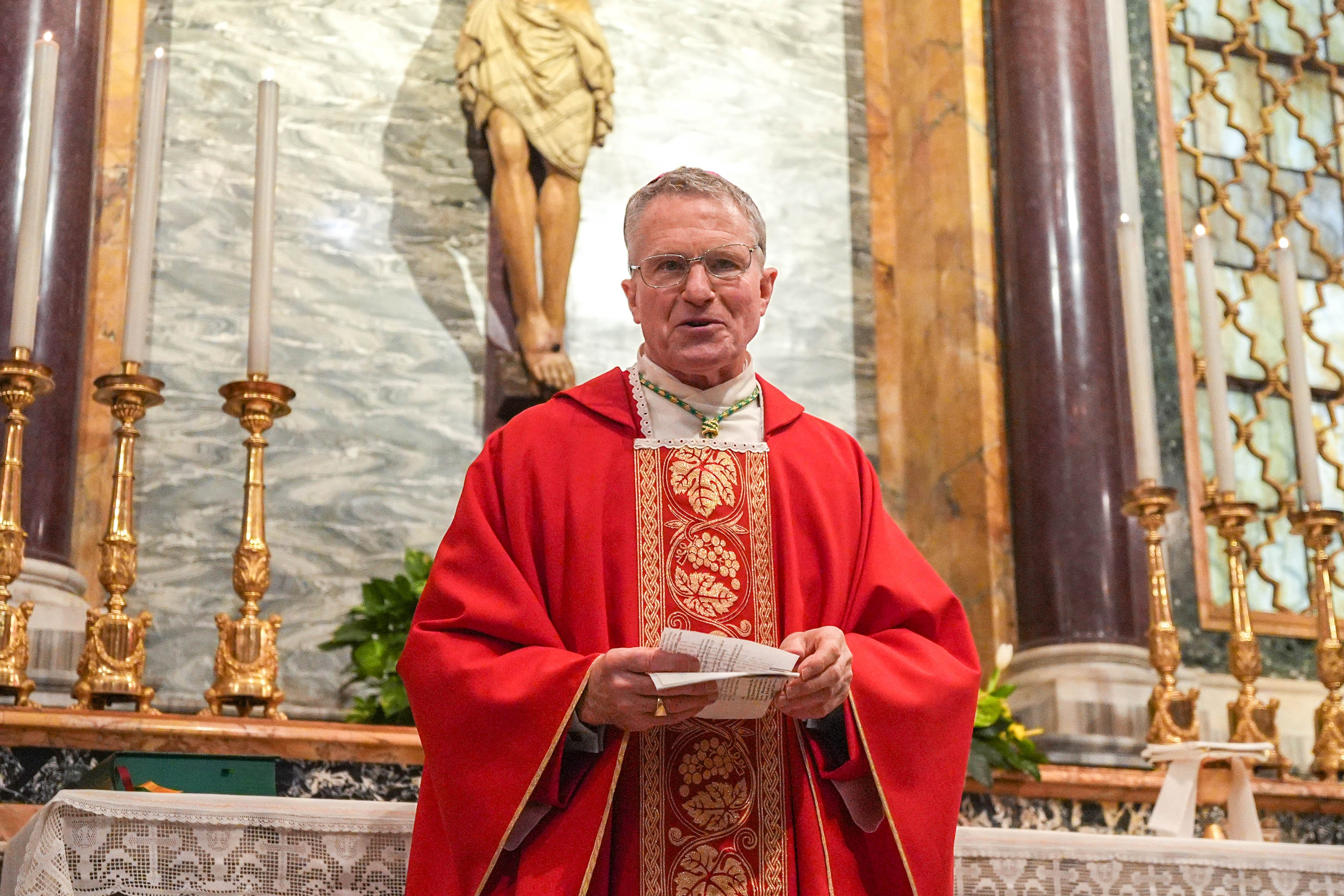U.S. bishops’ assembly focuses on the heart of Jesus after Church events, election year

U.S. elections, Synod on Syondality and the National Eucharistic Congress were discussed at USCCB assembly
BALTIMORE — On the first day of the public session of the U.S. bishops’ annual fall meeting in Baltimore, the importance of the Church’s mission in light of the just-concluded Synod on Synodality, the National Eucharistic Congress and the recently concluded U.S. election loomed large.
Cardinal Christophe Pierre, the apostolic nuncio to the U.S., shared with the bishops that Pope Francis’ new encyclical “Dilexit Nos” is a call to “return to the heart” of Jesus to understand the synod, National Eucharistic Revival and the upcoming Jubilee 2025 in Rome “as disciples and as bishops.”
“The deeper we go into His heart, the more strengthened we will be to proclaim the Good News together,” he said.
“Eucharistic Revival, a more synodal form of evangelization, a Jubilee Year of Hope: All of these experiences will produce fruit, provided that we return to the heart of Christ, that sacred place where human longing and divine love are united,” he said. “It is there, in the heart of Christ, where we rediscover in a personal way the ‘kerygma’ that we preach: Christ has become one of us, He has suffered and died to heal our wounds, He has risen, and He is alive with us now in the Spirit.”
The president of the U.S. Conference of Catholic Bishops, Archbishop Timothy P. Broglio of the U.S. Archdiocese for the Military Services, gave his address. He observed that the U.S. Church has many existing consultative structures for a synodal Church, while acknowledging it has more work to do. With respect to the three-year National Eucharistic Revival, he noted it “continues now in its phase of mission” to “help the faithful discover or deepen its meaning, and to prolong the positive effects of the first two years.”
Reflecting on the U.S. presidential election, he emphasized that the bishops “never backpedal or renounce the clear teaching of the Gospel” but “proclaim it in and out of season,” and that Christians generally speaking must be “catalysts for a more humane and worthy approach to daily life.”
“We must insist on the dignity of the human person from womb to tomb,” he said, emphasizing the Church’s commitments include seeing Christ in people in need, defending the poor, fighting the evil of racism and caring for migrants while calling for immigration reform.
“We certainly do not encourage illegal immigration, but we will all have to stand before the throne of grace and hear the Lord ask us if we saw Him in the hungry, thirsty, naked, homeless, stranger or sick and responded to His needs,” he said.
During the meeting, the U.S. bishops held an extensive open discussion on the Synod on Synodality, which recently concluded in Rome after a monthlong session in October, before they resolved in a voice vote to ask their Committee on Priorities and Plans to discern developing a task force to help the conference and dioceses implement the final synod document.
Baltimore Archbishop William E. Lori shared his experience as a delegate, saying it was both “enlightening” and “challenging” to go through the synod with delegates from around the world for those weeks. He emphasized that trust was at the heart of the synod experience and that synodality aimed to overcome polarization afflicting the Church “by seeking consensus in the Holy Spirit” through conversation and prayer.
Bishop Daniel E. Flores of Brownsville, Texas, who has led the USCCB’s involvement in the synod process, also briefed the bishops on the synod’s October meeting. He explained that much theological work still needs to be done alongside efforts to develop a synodal culture at the parish level, where most Catholics experience the Church.
“If it doesn’t reach the parishes, it hardly reaches the people of God,” he said.
It was recommended from the floor that Bishop Flores be empowered to lead the task force, and Bishop Flores said he would defer to leadership for that decision.
The U.S. bishops heard an update on the National Eucharistic Revival, which included a two-minute video that dramatically recapped the National Eucharistic Congress.
Bishop Andrew H. Cozzens of Crookston, Minnesota, and board chair of the National Eucharistic Congress Inc., told the bishops that participants provided overwhelmingly positive feedback about the congress and preceding four-route National Eucharistic Pilgrimage. He noted that more than 200,000 people joined the pilgrimage; 65,000 joined the congress’s procession in Indianapolis; and over 50,000 from every U.S. state and 23 countries joined the congress itself, with hundreds of thousands participating digitally.
Bishop Cozzens said the NEC is planning a National Eucharistic Pilgrimage from Indianapolis to Los Angeles next year and to also “assist regions and dioceses in forming their own congresses and to provide resources for formation.”
The bishops also showed support for local advancement of the sainthood causes of two women born in the 20th century: Benedictine Sister Annella Zervas of Moorhead, Minnesota, and Gertrude Agnes Barber, a laywoman from Erie, Pennsylvania.
The bishops also selected some of their number to fill several leadership positions. Archbishop Bernard A. Hebda of St. Paul and Minneapolis was voted in as treasurer-elect of the U.S. Conference of Catholic Bishops, along with several new committee chairs. Bishop Michael G. Woost of Cleveland was elected chairman-elect for the Committee on Divine Worship; Archbishop Shelton J. Fabre of Louisville, Kentucky, was elected chairman-elect of the Committee on Domestic Justice and Human Development; Bishop Edward J. Burns was elected as head of the Committee on Laity, Marriage, Family Life and Youth; and Bishop Brendan J. Cahill of Victoria, Texas, was elected chairman-elect of the Committee on Migration. The prelates assume their positions at the conclusion of the bishops’ 2025 fall assembly.
The bishops voted Nov. 13 to approve a new “mission directive” for 2025-28, a new way that the conference is presenting its strategic vision for the next four years.
For 2025-28, the new directive is more of a mission statement than a theme, and was overwhelmingly approved by a vote of 225-7, with two abstentions. The mission directive, which was shepherded by Archbishop Paul S. Coakley of Oklahoma City, chair of the conference’s Committee on Priorities and Plans, is as follows:
“Responding even more deeply to the call of Christ to proclaim the Gospel and form Missionary Disciples, the Committees and Staff of the USCCB, submitting to the inspiration of the Holy Spirit, will prioritize the work of the Conference to help equip bishops, clergy, religious, and the laity in evangelizing those who are religiously unaffiliated or disaffiliated from the Church, with special focus on young adults and the youth.”
USCCB held its fall assembly Nov. 11-14 in Baltimore
Subscribe to Read All St. Louis Review Stories
All readers receive 5 stories to read free per month. After that, readers will need to be logged in.
If you are currently receive the St. Louis Review at your home or office, please send your name and address (and subscriber id if you know it) to subscriptions@stlouisreview.com to get your login information.
If you are not currently a subscriber to the St. Louis Review, please contact subscriptions@stlouisreview.com for information on how to subscribe.






